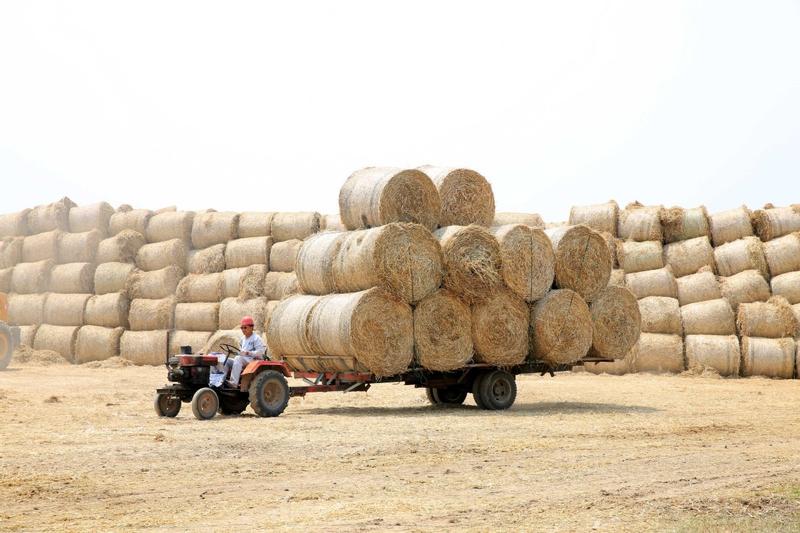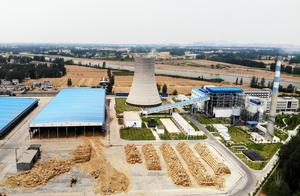 In this undated file photo, a worker transports straw to a biomass power plant from a storage site in Huaibei, Anhui province. (PHOTO BY LI XIN / FOR CHINA DAILY)
In this undated file photo, a worker transports straw to a biomass power plant from a storage site in Huaibei, Anhui province. (PHOTO BY LI XIN / FOR CHINA DAILY)
From plants and wood, to crops and animal droppings, all of these examples of organic waste could soon become important energy sources to heat homes and fuel cars.
Biomass, such as agricultural and forestry products, organic household waste as well as livestock and industrial refuse are some of the biological materials used as fuels in producing electricity and heat.
Biomass can be burned directly for heat, or converted to renewable gaseous and liquid fuels through thermal, chemical and biochemical processes.
Under the energy efficiency and carbon intensity targets set by the Chinese government, the country's development of biomass energy will see fast track growth thanks to preferential policy support, experts said.
"The development of the biomass energy industry in China has ushered in an important window period under China's strong green commitment and the industry has great potential for further growth," said Zhang Dayong, secretary-general of China's Biomass Energy Industry Promotion Association.
China vows to peak carbon emissions by 2030 and reach carbon neutrality by 2060.
By processing 40 percent of this (about 6.3 billion metric tons of organic waste on average per year) into (biomass) energy, which is a goal that is likely to be achieved in the near future, China can reduce its carbon dioxide emissions by 20 percent, which is about 2.3 billion tons. That is very meaningful for China's green development.
Zhang Dayong, secretary-general of China's Biomass Energy Industry Promotion Association
During the recently closed two sessions, China's commitment to green development was reiterated by Premier Li Keqiang.
While delivering the Government Work Report, Li said China plans to reduce energy consumption per unit of GDP by 13.5 percent and carbon dioxide emissions per unit of GDP by 18 percent during the 14th Five-Year Plan period (2021-25).
"China's strong green commitment will provide more opportunities of growth for biomass energy development as biomass is the only zero-carbon fuel among renewable energy sources. If it is equipped with BECCS technology, (bioenergy with carbon capture and storage), the process of turning biomass into energy can achieve negative emissions," Zhang said.
BECCS is the process of extracting energy from biomass and capturing and storing the carbon, thereby removing it from the atmosphere.
At present, China produces about 6.3 billion metric tons of organic waste on average per year, according to Zhang.
"By processing 40 percent of this into energy, which is a goal that is likely to be achieved in the near future, China can reduce its carbon dioxide emissions by 20 percent, which is about 2.3 billion tons. That is very meaningful for China's green development," Zhang said.
"Developing biomass is also meaningful in helping reduce reliance on fossil fuels and diversifying energy sources," Zhang added.
ALSO READ: Biomass liquefied to clean fuel
BEIPA said that each year China produces over 900 million tons of agricultural and forestry biomass which can generate power equal to that from nearly 400 million tons of coal. The number is even larger when adding organic waste from urban and rural areas.
However, at present only around 90 million tons of agricultural and forestry biomass is used for power generation annually.
Aside from stating energy efficiency and carbon intensity targets, the 14th Five-Year Plan also sent positive signals to encourage proper handling and comprehensive use of crops, which account for a large portion of raw materials for biomass in China, Zhang said.
A BEIPA report said more support from government to boost the industry's development is expected in the next five years.
The report estimated that about 1.2 trillion yuan (US$183.6 billion) will be invested in the industry from 2021 to 2025, which could help the industry handle about 350 million tons of organic waste, and create job opportunities for around 1 million people.
 This undated file photo shows a biomass power plant in Huaibei, Anhui province. (PHOTO BY LI XIN / FOR CHINA DAILY)
This undated file photo shows a biomass power plant in Huaibei, Anhui province. (PHOTO BY LI XIN / FOR CHINA DAILY)
By 2030, the proportion of biomass energy in renewable energy will increase to about 8 percent, according to the report.
"At present, China's development of biomass is still at an early stage but is developing at a fast pace," Zhang said.
Currently, a total of 466 projects have been put into operation or are under construction.
Last year, installed capacity of biomass power generation increased 5.43 million kilowatts to 29.52 million kW.
Biomass power generation reached 132.6 billion kilowatt-hours during the same period, a 19.4 percent increase year-on-year.
"The industry's development faces a lot of challenges. Currently, only about 5 percent of organic waste is processed into bioenergy-electricity and gas generated from biomass," Zhang said.
It is very meaningful to promote biomass for heating especially in counties and rural areas, where there are abundant raw materials like crops and animal waste. Through cogeneration of heat and power from biomass, and biogas production during the process of anaerobic fermentation, heating in those areas will have cleaner sources.
Li Yin, chairman of Jiuzhou Electronics
He explained that there are various reasons behind the relatively low processing rate of bioenergy. "The installed capacity of biomass power generation is very low, at about 30,000 kW on average per project, compared with 600,000 kW to 1 million kW for that of coal power generation, which means that the amount of electricity generated through a certain amount of biomass is far less than the same amount of coal, or other mainstream energy sources.
Lin Boqiang, head of the China Institute for Studies in Energy Policy at Xiamen University, said: "Insufficient collection of raw materials, such as crops, is another problem that hinders the industry's development.
"Sometimes the cost of transport and storage is even higher than the money farmers can get from selling crops, so many would rather burn the crops instead of hauling them to power generation plants.
"It is unlikely that they could sell the crops at higher prices considering current stable electricity prices."
High costs of collecting raw materials and relatively low generation rates of electricity compared with coal and other mainstream energy sources have made government subsidies an important support for the industry's development. However, the subsidies began to phase out in recent years, according to Lin.
Han Xiaoping, chief researcher at industry and energy website china5e.com, said new business models are expected, such as innovation in cooperation between power generation companies and farmers.
"More efforts are needed to improve the transportation, storage and sales networks of raw materials, as well as develop products with high added value and extend the industrial chain," Han said.
In addition to high costs of collecting raw materials and relatively low generation rates of electricity compared with coal and other mainstream energy sources, the development of biomass is also challenged by factors like low added value of biomass electricity generation, electricity generation and sales centered profit models as well as restrictions on bioenergy trading in the electricity market, said Li Yin, chairman of Jiuzhou Electronics.
"More diversified revenue sources of biomass energy aside from electricity generation, such as heating, are called for by government, industry experts and executives," Zhang said.
A recent document by the National Energy Administration called for support from local governments for biomass energy projects, with heating being a priority.
READ MORE: Chinese biomass energy producer CN Energy seeks US IPO
"It is very meaningful to promote biomass for heating especially in counties and rural areas, where there are abundant raw materials like crops and animal waste. Through cogeneration of heat and power from biomass, and biogas production during the process of anaerobic fermentation, heating in those areas will have cleaner sources," Li said.


